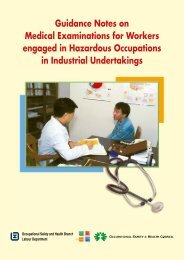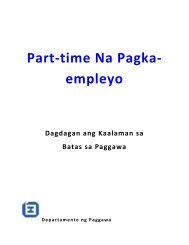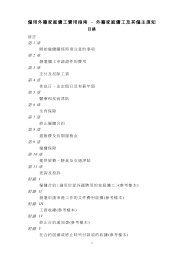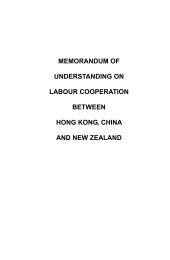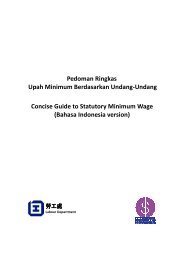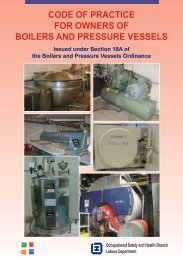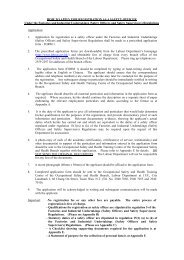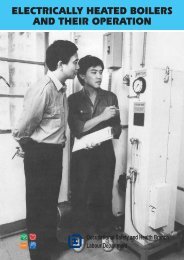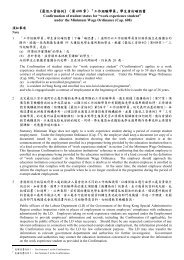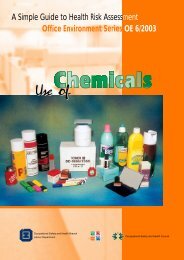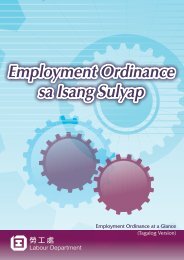Ventilation
Ventilation
Ventilation
You also want an ePaper? Increase the reach of your titles
YUMPU automatically turns print PDFs into web optimized ePapers that Google loves.
A Simple Guide to Health Risk Assessment<br />
Office Environment Series OE 4/2004<br />
Occupational Safety and Health Branch<br />
Labour Department
Contents<br />
Introduction ○<br />
○ ○ ○ ○ ○ ○ ○ ○ ○ ○ ○ ○ ○ ○ ○ ○ ○ ○ ○ ○ ○ ○ ○ ○ ○ ○ ○ ○ 1<br />
<strong>Ventilation</strong> of a building ○<br />
○ ○ ○ ○ ○ ○ ○ ○ ○ ○ ○ ○ ○ ○ ○ ○ ○ ○ ○ ○ ○ 1<br />
Purposes of ventilation ○<br />
○ ○ ○ ○ ○ ○ ○ ○ ○ ○ ○ ○ ○ ○ ○ ○ ○ ○ ○ ○ ○ ○ 2<br />
Risk assessment ○<br />
○ ○ ○ ○ ○ ○ ○ ○ ○ ○ ○ ○ ○ ○ ○ ○ ○ ○ ○ ○ ○ ○ ○ ○ ○ ○ 2<br />
Problems and solutions ○<br />
○ ○ ○ ○ ○ ○ ○ ○ ○ ○ ○ ○ ○ ○ ○ ○ ○ ○ ○ ○ ○ ○ 5<br />
Appendix 1 ○<br />
○ ○ ○ ○ ○ ○ ○ ○ ○ ○ ○ ○ ○ ○ ○ ○ ○ ○ ○ ○ ○ ○ ○ ○ ○ ○ ○ ○ 14<br />
Appendix 2 ○<br />
○ ○ ○ ○ ○ ○ ○ ○ ○ ○ ○ ○ ○ ○ ○ ○ ○ ○ ○ ○ ○ ○ ○ ○ ○ ○ ○ ○ 14<br />
Appendix 3 ○<br />
○ ○ ○ ○ ○ ○ ○ ○ ○ ○ ○ ○ ○ ○ ○ ○ ○ ○ ○ ○ ○ ○ ○ ○ ○ ○ ○ ○ 15<br />
Appendix 4 ○<br />
○ ○ ○ ○ ○ ○ ○ ○ ○ ○ ○ ○ ○ ○ ○ ○ ○ ○ ○ ○ ○ ○ ○ ○ ○ ○ ○ ○ 16<br />
Air conditioning system ○<br />
○ ○ ○ ○ ○ ○ ○ ○ ○ ○ ○ ○ ○ ○ ○ ○ ○ ○ ○ ○ ○ 17<br />
Third Edition November 2004
<strong>Ventilation</strong><br />
Introduction<br />
This guide is intended to help employers and employees assess the health risks associated<br />
with ventilation systems in their workplace. Such assessments can be no more than an<br />
examination of what, in the course of work, could possibly cause harm to people. With the<br />
help of this guide, you may identify hazards, the degree of risk and the possible solutions.<br />
<strong>Ventilation</strong> of a Building<br />
<strong>Ventilation</strong> is the process of supplying and removing air by natural or mechanical means<br />
to and from a building. The design of a building’s ventilation system should meet the<br />
minimum requirements of the Building (Ventilating Systems) Regulations.<br />
“Natural ventilation” covers uncontrolled<br />
inward air leakage through cracks, windows,<br />
doorways and vents (infiltration) as well as<br />
air leaving a room (exfiltration) through the<br />
same routes. Natural ventilation is strongly<br />
affected by weather conditions and is often<br />
unreliable.<br />
Natural <strong>Ventilation</strong><br />
Mechanical or forced ventilation is provided<br />
by air movers or fans in the wall, roof or<br />
air-conditioning system of a building. It<br />
promotes the supply or exhaust air flow in<br />
a controllable manner.<br />
Mechanical <strong>Ventilation</strong><br />
1
<strong>Ventilation</strong><br />
Purposes of <strong>Ventilation</strong><br />
<strong>Ventilation</strong> in a building serves to provide fresh and clean air, to maintain a thermally<br />
comfortable work environment, and to remove or dilute airborne contaminants in order to<br />
prevent their accumulation in the air. Air-conditioning is a common type of ventilation<br />
system in modern office buildings. It draws in outside air and after filtration, heating or<br />
cooling and humidification, circulates it throughout the building. A small portion of the<br />
return air is expelled to the outside environment to control the level of indoor air<br />
contaminants.<br />
An air-conditioning system<br />
The efficiency of a ventilation system can be evaluated through investigation of<br />
environmental factors such as the quality of supply air, the thermal comfort conditions of<br />
the occupied space and the level of airborne contaminants therein.<br />
Risk Assessment<br />
The following checklist is designed to help you examine the environmental factors and<br />
assess the health risks in your workplace. Answer all the questions and if your answer(s) is<br />
the same as that indicating “potential hazards”, there are deficiencies in the safety<br />
management system or the ventilation is inadequate . You are advised to go through the<br />
guidance materials presented in the following sections and apply suitable solutions to<br />
eliminate or reduce the health hazards. Should you get matched answers in question marked<br />
with ☞, health risks are imminent and immediate remedial actions are required.<br />
The checklist may not cover all the situations in your workplace. You are free to add more<br />
questions or modify them to suit your specific needs.<br />
2
<strong>Ventilation</strong><br />
Design and General Operation<br />
Answers indicating<br />
potential hazards<br />
1. Do people complain that the indoor air is stuffy? Yes<br />
2. Do people notice unusual odour from the ventilation Yes<br />
duct which is not related to activities in the office<br />
(e.g. cooking odour) or from outdoor sources?<br />
☞<br />
Effect of unrelated activity<br />
e.g. food odour, or fishy smell.<br />
3. Do people complain that the indoor air is too dry, too humid, Yes<br />
hot or cold?<br />
4. Do people complain that the indoor air is draughty or Yes<br />
stagnant?<br />
☞<br />
☞<br />
Draughts may cause discomfort.<br />
5. Is there a regular maintenance programme for the ventilation No<br />
system?<br />
6. If the building’s original design has been changed by the No<br />
addition of walls or temporary room partitions, has<br />
the ventilation system been adjusted and tested to accommodate<br />
the new environment?<br />
Effects of Renovation Works<br />
7. Is there any renovation work going on in a nearby location or in Yes<br />
a location such that the air quality of your office is affected?<br />
Specific Contaminant Sources<br />
Stagnant air may cause drowsiness<br />
8. Do people complain of headaches, decreased alertness or nausea Yes<br />
after spending some time in the workroom and yet often no<br />
particular odour is detected?<br />
3
<strong>Ventilation</strong><br />
☞<br />
☞<br />
☞<br />
9. Do people complain of eye irritation, dry or sore throats, Yes<br />
nosebleeds or headaches? (These are often associated with<br />
a pungent odour.)<br />
10. Do people complain of having eye, nose or throat discomfort, Yes<br />
contact lens problems, skin irritation or respiratory difficulties?<br />
11. Do people complain of solvent or chemical odours from Yes<br />
unknown activities/sources?<br />
Smoking Solvents Chemicals<br />
Chemicals<br />
☞<br />
☞<br />
Some potential sources of complaints<br />
12. Is there visible dust or dirt build-up around diffusers, ducting, Yes<br />
air handling units or cooling towers?<br />
13. Is smoking prohibited in the office or allowed only in a room No<br />
with an independent ventilation system?<br />
14. Is there evidence of mould growth on structural materials or Yes<br />
inside the ventilation system?<br />
15. Has there been a recent increase in the number of illnesses Yes<br />
among people, especially asthma and flu-like illnesses?<br />
16. Is the air conditioning system equipped with freshwater Yes<br />
cooling tower?<br />
A water cooling tower<br />
4
<strong>Ventilation</strong><br />
Problems and Solutions<br />
Design and General Operation<br />
1. Good air flow in a workplace is very important for productive and healthy work.<br />
Adequate ventilation can maintain the freshness of air, prevent accumulation of heat<br />
and control the level of airborne contaminants. When there is a lack of air movement,<br />
or over-crowding, people often feel stuffy. (See also Appendix 1)<br />
Solutions<br />
● Reduce activities in a location, if it is too crowded.<br />
●<br />
●<br />
Check the adequacy of ventilation by measuring the indoor carbon dioxide level.<br />
If its level is usually greater than 1000 ppm, this may indicate a problem with the<br />
ability of the ventilation system to remove normal contaminants from human<br />
occupants and to satisfy comfort (odour) criteria. Further investigation is necessary<br />
to decide what improvement measures will be required. If there are strong sources<br />
of certain contaminants, a comprehensive assessment is required.<br />
Increase the supply of fresh air to the building. The rate required depends on the<br />
number of occupants and the nature of the indoor activities. See Appendix 2 for<br />
fresh air supply rate for general work activities in air-conditioned offices.<br />
2. Unusual odour can emanate from internal or external sources. However, odour from<br />
the ventilation system is often associated with problems at the intake points. Intake<br />
points too close to an exhaust outlet should be avoided. See Appendix 3 for odours as<br />
indicators.<br />
Solutions<br />
●<br />
Intake points should not be too<br />
close to exhausts<br />
Relocate air intake points away from pollutant sources, including building and<br />
automobile exhausts. They are better located at an elevated position.<br />
●<br />
Install filters with odour absorbers (e.g. activated carbon) to remove the odour.<br />
5
<strong>Ventilation</strong><br />
3. A comfortable environment may improve productivity and reduce errors and accidents.<br />
Excessive heat can strongly influence working capacity. <strong>Ventilation</strong> is essential for<br />
maintaining an acceptable environment in terms of humidity, heat or cold. In a normal<br />
air-conditioned workplace, temperature and humidity can be controlled - the optimum<br />
temperature range is 20ºC - 26ºC and relative humidity 40% - 70%. A poorly designed<br />
ventilation system may cause uneven distribution of the supply air, resulting in cooler<br />
environment at the front part of the ventilation line, and warmer at the back.<br />
Short-circuit of air Air inlet Air outlet<br />
Air inlet and air outlet are too close causing air short-circuiting and poor distribution<br />
of air<br />
In general, you may consider the following options to improve the situation:<br />
●<br />
●<br />
●<br />
●<br />
●<br />
Provide shielding from solar heat/sunshine by screens or external louvers at the<br />
window sides.<br />
Use insulation material under roofs or on walls to keep the heat away.<br />
Use light colour paint for decoration of the building’s external walls.<br />
Isolate heat-generating machines and processes.<br />
Increase natural ventilation with fans and ventilators.<br />
Natural ventilation supplemented with<br />
ventilators can improve air circulation.<br />
6
<strong>Ventilation</strong><br />
If an air-conditioning system is installed, the following points may also be considered:-<br />
●<br />
●<br />
Ensure occupants are clothed appropriately.<br />
Check that thermostats are working properly, calibrated and not obstructed by<br />
objects.<br />
Avoid blocking air flow<br />
●<br />
●<br />
Remove obstructions that block air flow, and unlock diffusers and return air grilles.<br />
Flow system rebalancing and redesign of the distribution system may be necessary.<br />
4. Air motion in a room is an important comfort factor. Too much air movement causes<br />
draughts which are annoying. If there is little air movement, people may complain of<br />
stuffiness.<br />
Solutions<br />
●<br />
Adjust diffusers and return air grilles where necessary.<br />
●<br />
Rearrange movable partitions to avoid unwanted air currents or blockage of air<br />
flow.<br />
Unbalanced ventilation may disturb the room temperature and air distribution. Tampering<br />
with an air outlet may further upset the balance<br />
●<br />
Flow system rebalancing or redesign of the distribution system may be necessary.<br />
7
<strong>Ventilation</strong><br />
5. Regular maintenance helps to keep the ventilation system clean and functioning<br />
properly. A responsible person should be assigned to oversee the maintenance<br />
programme and to keep records.<br />
Poor maintenance may create an ideal breeding ground for micro-organisms.<br />
Solutions<br />
● Draw up a maintenance/repair programme for detecting and fixing problems,<br />
including leakage and cleaning of dirt.<br />
● Assign a responsible person to take care of the system.<br />
6. It is not unusual that alteration of the interior structure has not taken into account the<br />
potential impact on the ventilation. Partition walls, dividers, cabinets or even stacked<br />
boxes could block ventilation duct inlets or outlets. Reassessment is required if the<br />
occupied building is to be used differently from the way it was originally planned (for<br />
instance if an open-plan office is to be changed into closed offices).<br />
Solution<br />
● Ask a ventilation engineer to check and redesign the system.<br />
Effects of Renovation Work<br />
7. Renovation work is a common source of problems in an office building with limited<br />
open windows for natural ventilation. The activities give out dust, solvent vapour,<br />
dirt, noise, vibration and the annoying conditions can extend to the surrounding offices.<br />
The situation may get worse if they share the same ventilation system. It may lead to<br />
complaints.<br />
Solutions<br />
●<br />
Isolate the renovation site by physical barrier or have the work done outside office<br />
hours.<br />
●<br />
●<br />
Provide exhaust ventilation and fresh air supply, and maintain negative pressure<br />
in the renovation area.<br />
Only have essential work done on site; avoid painting furniture or movable parts<br />
in the area. This should be carried out in a workshop rather than the office.<br />
8
<strong>Ventilation</strong><br />
Specific Pollutant Sources<br />
8. Headaches, decreased alertness and nausea are non-specific symptoms but when they<br />
occur frequently, are likely to be associated with the presence of air contaminants<br />
from a definite source(s) which the existing ventilation is not capable of controlling.<br />
Carbon monoxide is a colourless, odourless toxic gas usually produced by incomplete<br />
combustion. Symptoms of low-level exposure to carbon monoxide are very similar to<br />
those described.<br />
Solutions<br />
●<br />
Check whether there are combustion sources, such as stoves burning fossil fuel or<br />
exhaust from engines located inside the building. Remove or relocate any sources<br />
of combustion.<br />
●<br />
Check whether the ventilation air inlets are close to any car parks or major traffic<br />
lanes. Relocate the inlets if necessary.<br />
●<br />
Increase exhaust ventilation to the problem area.<br />
9. Eye irritation, dry and sore throats, nosebleeds and headaches are symptoms of exposure<br />
to formaldehyde vapour, a colourless irritating gas with a pungent odour. It is also a<br />
sensitiser. Building materials or new furniture, carpets and fabrics are the most common<br />
sources of the vapour. Low level exposure to the vapour is possible when slight offgassing<br />
happens. It may last for years if the ventilation is poor. Care must be taken<br />
with it from the earliest stage of building design.<br />
Solutions<br />
●<br />
Do not select any building material, furniture or fixture that may emit<br />
formaldehyde. If you do, allow off-gassing before installation.<br />
●<br />
Improve fresh air supply by opening windows.<br />
●<br />
Remove or reduce the source by relocating to a better ventilated space.<br />
●<br />
Seal off the gassing material with a suitable substance such as polyurethane varnish.<br />
9
<strong>Ventilation</strong><br />
10. The signs and symptoms referred to in question 10 are associated with exposure to<br />
dust and particulates. The particles may originate from external or internal sources<br />
and both synthetic and natural fibres that are used in building insulation may cause<br />
problems. A detailed investigation is needed to tackle the problem.<br />
Solutions<br />
●<br />
Check any damage to insulation along ducting or in air handling units. Repair<br />
immediately if necessary.<br />
●<br />
Upgrade the filters.<br />
11. Thousands of organic chemicals and solvents are in common use. Volatile compounds<br />
from them are collectively known as Volatile Organic Compounds (VOCs). A large<br />
variety of VOC sources, such as plastics, floor wax, furniture, structural materials,<br />
printers, copiers or stationery could be found in an office. Some of the common VOCs<br />
are tabled in Appendix 4. Poor ventilation may aggravate the effects of VOCs causing<br />
eye irritation and other symptoms. (Please refer to “Use of Chemicals” in the same<br />
series).<br />
Solutions<br />
●<br />
Eliminate all potential sources of VOCs as far as possible.<br />
●<br />
Provide extra ventilation or separate ventilation in areas where large amounts of<br />
VOCs are being emitted, e.g. from a process involving the use of organic solvents.<br />
●<br />
Install local exhausts for specific processes that generate large amounts of VOCs,<br />
e.g. printing machines, blueprinters.<br />
12. Dirt or dust built-up around diffusers, ducting, etc. indicates that the ventilation system<br />
has not been adequately maintained, or that the air from inlets is not clean. Health of<br />
the workers may be affected.<br />
Solutions<br />
●<br />
Check the ventilation system and remove any dirt that has accumulated in the air<br />
circulating units and the ducting.<br />
●<br />
Review the maintenance programme and ensure cleaning is carried out more<br />
frequently.<br />
●<br />
Eliminate or relocate the air intake points so that clean air is supplied.<br />
●<br />
Install more effective filters to the ventilation system.<br />
10
<strong>Ventilation</strong><br />
13. Smoking produces an offensive odour and harmful substances. It can adversely affect<br />
health and relationships at work. A workplace should have a smoking policy in order<br />
to limit the effects of environmental tobacco smoke.<br />
Solutions<br />
●<br />
Identify and physically separate smoking and non-smoking areas. Provide them<br />
with independent ventilation systems.<br />
●<br />
Supply more fresh air to the smoking area but keep it under negative pressure<br />
compared with surrounding occupied rooms. As a rule of thumb, the recommended<br />
fresh air supply should usually be more than double the normal requirement.<br />
Smoking affects health and<br />
may damage office<br />
relationships.<br />
●<br />
Avoid recirculation of air that contains contaminants.<br />
●<br />
The best solution is to ban smoking inside offices.<br />
Adopt a non-smoking policy<br />
11
<strong>Ventilation</strong><br />
14. Micro-organisms, such as mould or fungi, bacteria, viruses, protozoa, can be found<br />
indoors. Mould or fungal growth on structural materials is a sign that biological growth<br />
in the area is flourishing. High air humidity, stagnant water, filters packed with dusts<br />
and building structures that have been damaged by moisture all provide favourable<br />
conditions for biological growth.<br />
Mould growth on dirty filters<br />
Solutions<br />
●<br />
Remove potential water sources that may encourage fungal growth, especially<br />
stagnant water in ventilation systems.<br />
●<br />
Repair and maintain all water pipes and drainage systems.<br />
●<br />
Repair areas that have been affected by flood or seepage as soon as possible.<br />
●<br />
Remove and replace contaminated porous materials, such as heavily deposited<br />
ventilation unit filters, mouldy ceiling tiles and mildewed carpets.<br />
Mildewed carpets<br />
●<br />
Disinfect all smooth surfaces (such as wall tiles) that have been contaminated by<br />
fungi.<br />
●<br />
Provide dehumidifier units for control of humidity within the optimum range.<br />
12
<strong>Ventilation</strong><br />
15. Micro-organisms like viruses, bacteria, rickettsia, and chlamydia can cause diseases<br />
and may be transmitted by air. Exposure to fungi or spores of micro-organisms can<br />
induce allergic reactions such as allergic rhinitis or asthma.<br />
Micro-organisms may cause diseases.<br />
Solutions<br />
●<br />
Use efficient filters in ventilation units to remove airborne particulates and spores<br />
of micro-organisms from the ventilation system. This will help to prevent the<br />
spread of diseases.<br />
●<br />
People who do not feel well should seek for medical treatment.<br />
16. Legionnaires’ Disease is caused by the bacteria, Legionella pneumophila and is typically<br />
manifested as severe pneumonia often culminating in respiratory failure. Cooling<br />
towers, evaporative condensers and hot water systems can become their growth and<br />
distribution sites. They flourish well in stagnant and contaminated freshwater sources<br />
of ventilation units.<br />
Solutions<br />
● Remove all potential nourishing water sources for Legionella, such as stagnant<br />
water in drip pans, cooling coils and sumps.<br />
●<br />
Clean humidifiers or ventilation units regularly (e.g. bimonthly or quarterly).<br />
●<br />
Use air cooled condensers instead of freshwater cooling towers as far as possible<br />
in the design of air-conditioning systems.<br />
●<br />
If freshwater cooling tower is used, effective dosage of chemicals and biocides<br />
should be added regularly to the water tank of the cooling tower to prevent rusting<br />
and growth of algae and bacteria.<br />
13
<strong>Ventilation</strong><br />
Appendix 1<br />
General Indicators to Call Attention to Pollutant Sources<br />
1. Visible dust or deposits on surfaces, such as desk, top of a cupboard.<br />
2. Overcrowding in the office.<br />
3. Unsanitary conditions - such as visible dirt, littering.<br />
4. Odours including body odour, solvent or chemical smell.<br />
5. Moisture problems, as indicated by visible fungal growth in corners.<br />
6. Staining and discolouration of false ceilings, walls or carpets.<br />
7. Presence of chemical substances in work areas.<br />
8. Smoking in the office.<br />
Appendix 2<br />
Fresh air supply rate for general work activities in<br />
air-conditioned offices<br />
Types of work activity<br />
Minimum fresh air<br />
supply rate<br />
(m 3 /min/person)<br />
Open plan office (non-smoking) 0.43<br />
Private office (with moderate smoking) 0.6<br />
Conference rooms or offices (with heavy smoking) 1.0<br />
Note: Local exhaust should be provided if harmful substances are generated.<br />
14
<strong>Ventilation</strong><br />
Appendix 3<br />
Odours as Problem Indicators in Office Buildings<br />
Description Problems<br />
Complaints<br />
Auto exhaust, diesel Vehicles or engine (high carbon Headaches, nausea,<br />
fumes monoxide* level) dizziness, tiredness<br />
Body odour Overcrowding, low Headaches, tiredness,<br />
ventilation rate (high carbon stuffiness<br />
dioxide level)<br />
Chlorine odour Leakage of cleaning agent Eye, nose and throat<br />
irritation<br />
Musty smell Microbial material, wet Allergic symptoms like eye<br />
surfaces<br />
itchiness, watering eyes,<br />
sneezing, cough<br />
Chemical smell Formaldehyde, pesticides, Eye, nose, and throat<br />
other chemicals<br />
irritation<br />
Solvent smell VOCs, emission from Odour, allergic symptoms,<br />
furniture, etc.<br />
dizziness, headaches<br />
Wet cement, dusty, Particulates, humidification Dry eyes, respiratory<br />
chalky smell system problems, nose and throat<br />
irritation, skin irritation,<br />
coughing, sneezing<br />
Sewage gas odour Floor drain water-traps in Foul smell, bad egg smell<br />
washrooms or basement dry up<br />
* Carbon monoxide itself is odourless and colourless.<br />
15
<strong>Ventilation</strong><br />
Appendix 4<br />
Commonly Encountered VOCs and Their Sources in Offices<br />
Chemicals<br />
Acetone<br />
Sources<br />
Paint, coatings, finishers, paint remover and<br />
thinner, caulking compound, correction fluids<br />
Aliphatic hydrocarbons (octane,<br />
decane, undecane, hexane,<br />
isodecane, mixtures)<br />
Paint, adhesive, gasoline, combustion<br />
sources, liquid process photocopier, carpet,<br />
linoleum,caulking compound<br />
Aromatic hydrocarbons (toluene,<br />
xylenes, ethylbenzene, benzene)<br />
Combustion sources, paint, adhesive,<br />
gasoline, linoleum, wall coating<br />
Chlorinated solvents (dichloromethane<br />
or methylene chloride, trichloroethane)<br />
Upholstery and carpet cleaner or protector,<br />
paint, paint remover, lacquers, solvents,<br />
correction fluids, dry-cleaned clothes<br />
n-Butyl acetate<br />
Acoustic ceiling tile, linoleum, caulking<br />
compound<br />
Dichlorobenzene<br />
Carpet, moth crystals, air fresheners<br />
4-Phenyl-cyclohexene (4-pc)<br />
Carpet, paint<br />
Terpenes (Limonene, a-pinene)<br />
Deodorizers, cleaning agents, polishes,<br />
fabrics, fabric softener, cosmetics,<br />
burning cigarettes<br />
16
<strong>Ventilation</strong><br />
Exhaust Air<br />
Damper Actuators<br />
Outdoor Air Intake<br />
Outdoor Air Damper Mixing<br />
Chamber<br />
Fan<br />
Filter<br />
Freeze Station<br />
Mixed Air Station<br />
Supply Air Diffusers<br />
Heating Coil<br />
Return Air Grid<br />
Humidifier Cooling Coil and Drip Pan<br />
Outdoor Air<br />
Temperature Sensor<br />
Air Handling Unit<br />
Air conditioning system<br />
17
Further Information<br />
For further assistance or information about the subject, you can contact<br />
Address<br />
: Occupational Safety and Health Branch,<br />
Labour Department<br />
15/F, Harbour Building<br />
38 Pier Road, Central<br />
Hong Kong<br />
Tel : 2852 4041<br />
Fax : 2581 2049<br />
Home Page address : http://www.labour.gov.hk<br />
E-mail address : enquiry@labour.gov.hk<br />
Other Titles in the Office Environment Series<br />
1. Introduction and Housekeeping<br />
2. Lighting in Offices<br />
3. Photocopying<br />
4. <strong>Ventilation</strong><br />
5. Office Workstation Design<br />
6. Use of Chemicals<br />
7. Manual Handling<br />
THIS GUIDE IS<br />
The Labour Department's contribution towards safety and health - a shared responsibility<br />
- and the Department's endeavour to serve the community.<br />
11/2004-3-OHB63<br />
Printed by the Printing Department<br />
(Printed on paper made from woodpulp derived from renewable forests)



